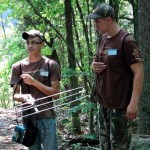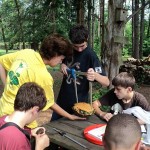About
Eastern box turtles are primarily terrestrial turtles. Named for the dome-shaped carapace, or shell, they can close up almost completely, protecting softer parts of the body from predators.
Scientists are interested in locating and studying box turtles to learn more about the statewide distribution. By tracking local populations in areas across the state, we can help scientists to estimate the number of box turtles in North Carolina and to better understand the range and habitats of these turtles.
Project Overview
Students search for box turtles on their own and with trained dogs. We mark the turtles found for later identification, measure and release them into the habitat with hopes of finding them again next year.
Some of the turtles found in earlier studies were fitted with radio transmitters. We use radio telemetry equipment to find these turtles each summer and mark coordinates for their locations.
Inquiry Questions
What is the population estimate of box turtles at our HRE study sites?
What is the range of individual box turtles?
Data Collection
On one or two days during each summer session, Boykin spaniel dogs, trained to catch box turtles, accompany students into the field. With a keen sense of smell, the dogs are much more efficient at finding and retrieving box turtles. On days when the dogs were working, we found multiple turtles, ranging between four and twenty-four. We use flagging tape to mark the exact location where each turtle is captured and use a GPS unit to determine the coordinates for this location.
Students consult a field data collection notebook to determine the appropriate marking for individual turtles. They mark each turtle by filing a series of notches in the edge of the turtle shell.
Students work in pairs to weigh each turtle and collect other morphological data such as sex, scute count, and presence or absence of injuries. All turtles are photographed (both carapace and plastron) and released at the point of capture. Atmospheric conditions and water temperature data are also recorded.
Six box turtles were eventually fitted with radio transmitters. Students use radio telemetry equipment to find turtles at a later time and record the new turtle locations. These box turtles are tracked multiple times during the year.
Data Sheets
We use the following data sheet for recording data in the field.
CCR Box Turtle Connection Capture Datasheet 2010 (Word)
CCR Box Turtle Connection Capture Datasheet 2010 (PDF)
Number of Box Turtles Identified
SSA students have been collecting data since June 2007. Since that time, we have found approximately 100 box turtles at Camp Chestnut Ridge.
Eastern Box Turtle (Terrapene carolina) data for HRE studies
2007 – 7 box turtles
2008 – 28 box turtles
2009 – 15 box turtles
2010 – 16 box turtles
2011 – 1 box turtles
2012 – 12 box turtles (CCR); 13 box turtles (ELG); 1 box turtle (Elon); 2 box turtles (Cedar Rock Park); 1 box turtle (Rockfish)
2013 – How many will we find this year?
Additional Resources
The HRE Box Turtle Research connects to the state-level initiative we call The Box Turtle Connection. Check out the link to their Web resource below.


